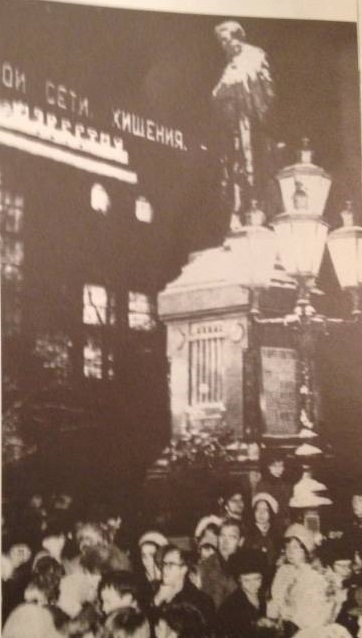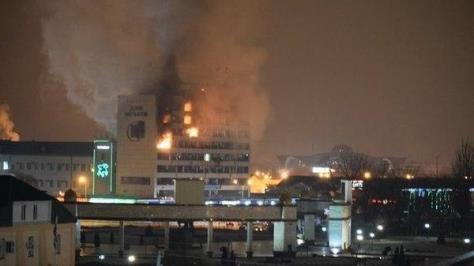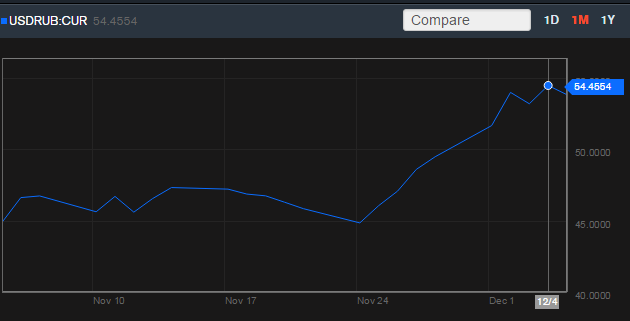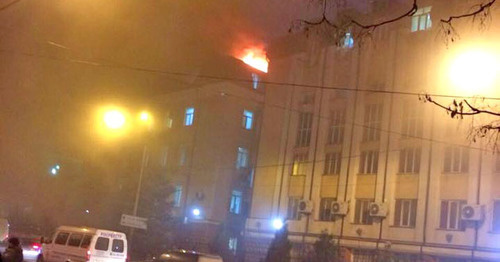Welcome to our column, Russia Update, where we will be closely following day-to-day developments in Russia, including the Russian government’s foreign and domestic policies.
The previous issue is here, and see also our Russia This Week and feature Is Putin Really Reining in Hard-Liners? Fact-Checking Gordon Hahn’s Article In The Moscow Times
Terrorists who bombed a train station and bus in December 2013 have been sentenced to 19 years of labor camp, and their helpers to 3 years, 10 months of labor colony. Two attacks, in which 40 people were killed and more than 100 injured, rocked Russia before the Olympics last year, which ultimately passed without incident. But the gunfight leaving 10 police and 6 terrorists dead in Grozny this week indicate that the insurgency in the North Caucasus continues.
Please help The Interpreter to continue providing this valuable information service by making a donation towards our costsâ€.
UPDATES BELOW
Three years ago today on December 5, 2011, thousands took to the streets of Moscow to protest against unfair and stolen elections in Russia.
Tonight, 8 protesters took to the streets holding a sign that read “Yesterday Kiev — Tomorrow Moscow,” a reference to both the Euromaidan revolution in Ukraine and the anniversary of the anti-Putin protests. They lit flares and chanted slogans as they walked toward Lubyanka Square, but were arrested by police.
The entire incident was caught on this video:
The demonstrators were marking the anti-Putin marches of three years ago on December 5 — but in fact that date had an even earlier history, which was why it was chosen in 2011.
December 5 used to be celebrated as “Constitution Day” in the Soviet era. The dissident mathematician Aleksandr Yesenin-Volpin had the idea that at the very least, the Soviet government should be called on to respect its own Constitution, despite its inherent flaws (like allowing only one leading party and communist ideology.).
He and his colleagues were the first to gather in a demonstration on December 5, 1965, in front of the Pushkin statute to protest the closed trial of writers Andrei Sinyavsky and Yuli Daniel for “anti-Soviet” books. They called their action a “glasnost” [openness] meeting some 20 years before President Mikhail Gorbachev popularized the term. Yesenin-Volpin was imprisoned in a psychiatric hospital for his dissent and ultimately emigrated to the US.
The demonstrations then became an annual tradition.

Newspaper photo of Moscow demonstration December 5, 1965.
The Russian Interior Ministry has updated to 14 the number of
policemen killed in the gun fight with terrorists in the Press House in
Grozny, Chechnya, TV Rain reports. Chechen President Ramzan Kadyrov has also announced a higher total of insurgents killed: 11.
One civilian was also killed in the attack, Vladimir Voroboyev, a
furniture store owner who ran the Association of Young Entrepreneurs,
located in the media building.

Families of those killed or wounded, which number at least 28, will
get a million rubles, which is worth about $53,000 now, Kadyrov
announced.
28 police were reportedly wounded in the attack, and evidently some have died of their wounds.
The attack of the Press House at 1:00 am December 4 was made in
three hijacked taxis. Police and FSB, Interior Ministry and Emergencies
Ministry surrounded the building with armored personnel carriers and
mortar launches and fired on the building, killing 11 insurgents inside.
Terrorists later took over School No. 20 and were blocked by
police. It is not know if all of them were killed or if any remain at
large. The Investigative Committee is opening up a case on charges of
“illegal armed formation” and “unlawful possession of weapons” and a
group of 50 detectors and forensic experts are already at work.
Meanwhile, Ramzan Kadyrov, who visited Putin at the Kremlin yesterday, accuses Akhmat Umarov, the brother of assassinated terrorist leader Doku Umarov of organizing the attack, TV Rain reported, citing Interfax.

Umarov was reported to be assassinated by Russian troops last year, and was replaced by Ali Abu Mukhammad,
an Avar from Dagestan. Doku Umarov had taken responsibility for the
2009 explosion of the Neva Express train, the Moscow metro explosion of
2010 and the bomb in Domodedovo Airport in 2011. The UN Security Council
placed Umarov in the list of international terrorists related to Al
Qaeda.
Analysts of the North Caucasus insurgency have recently reported splits in the movement as some have fought in Syria and supposedly changed their allegiance to former ISIS leader Abu Bakr al-Baghdadi. But as Jamestown analyst Mairbek Vatchaganov explains,
this could be an FSB provocation to disorient terrorist groups as there
are unexplained factors, such as how one Chechen fighter who reportedly
fought on the Kiev side in the war in southeastern Ukraine was able to
then go to Kazakhstan, get arrested, and yet be released to go back to
Dagestan.
And portraying the Caucasus Emigrate as part of the international
terrorists in ISIS in Syria could be part of Moscow’ efforts to blame
the outside world for domestic terrorism, and pressure the West to
support Syrian leader Bashar al-Assad in his battle of enemies,
including ISIS.
Chechen terrorists have indeed fought in Syria.
But in the video statement released in connection with this latest attack in Grozny, the Caucasus Emirate members didn’t mention
Syria, saying they were under orders of CE leader Emir Abdu Mukhammad and Emir Khamzat, a CE commander. They focusing only on “an act of Revenge for the fact that the murtadi (apostates) dared to oppress Muslim women, our sisters” by which they apparently mean that the brand
of state Islam enforced by Kadyrov is not as strict as Islamists would
like.
Chechen terrorists have indeed fought in Syria.
But in the video statement released in connection with this latest attack in Grozny, the Caucasus Emirate members didn’t mention
Syria, saying they were under orders of CE leader Emir Abdu Mukhammad and Emir Khamzat, a CE commander. They focusing only on “an act of Revenge for the fact that the murtadi (apostates) dared to oppress Muslim women, our sisters” by which they apparently mean that the brand
of state Islam enforced by Kadyrov is not as strict as Islamists would
like.
— Catherine A. Fitzpatrick
Yelizaveta Surganova reports for Forbes Russia that the independent TV Rain (Dozhd) channel will have to vacate their current premises at the former Red October confectionery factory in Moscow.
The channel currently share space in the factory, let out by Guta-Development, with the liberal magazine, Snob. Previously, the television channel had occupied premises next-door.
In March this year, as the channel faced severe difficulties after it was publicly attacked by state-owned media and dropped by satellite broadcasters, Guta-Development informed TV Rain that they would not be able to stay in their studios beyond June. However the two parties came to an agreement that the channel could remain at Red October until the end of the year as they sought new premises.
But in October Guta-Development asked TV Rain to vacate their premises ahead of schedule, claiming that repair work needed to be carried out. TV Rain then began sharing Snob‘s offices.
Surganova writes that a source, close to the management of the channel, has told her that TV Rain now has until Monday, December 8, to leave their current studio:
“Today we were politely asked to cease broadcasting from, and vacate the premises.”
Natalya Sindeyeva, the owner and director-general of TV Rain confirmed the report, though did not explain what issues had arisen between her channel and Snob.
Nikolay Uskov, the director of the Snob project, has not been available for comment so far.
The channel will, from December 8, be broadcasting from a temporary studio which may, Surganova writes, be located in an employee’s apartment.
Russian state regulators have continued to pursue the broadcaster. Surganova notes that the regional branch of Roskomnadzor, the state broadcasting and media authority, had sent letters to television carriers in the Moscow area, demanding to know if they broadcast TV Rain, and if so, a copy of their contract with the channel. Roskomnadzor later claimed that this was because the channel changed the address of their editorial board but had not disclosed this to the regulator.
Sindeyeva said that the matter with Roskomnadzor had been settled and the regulator had been sent updated details. She added however, that the channel would not renew their broadcasting license until a new, permanent, studio had been found.
According to Sindeyeva, the channel is considering several premises at the moment. She said:
“If we find premises tomorrow that we can move into, we are ready to go in that day and begin installing the studio. We’d need a month for the installation of a complete studio.”
All translations by The Interpreter.
— Pierre Vaux
Officials are saying that the fire at the FSB building is caused by a short circuit, Interfax reports.
The roof and the attic of the FSB building in Makhachkala, the
capital of Dagestan, are in flames today, as Russian media and bloggers
have reported.
An Interfax correspondent in Makhachkala reported (translation by The Interpreter):
The roof of an administrative building on Lenin Square is burning,
five fire-fighting units are on the scene, the fire has been localized,
said a representative of the Emergencies Ministry for Dagestan.
A source in the FSB told Interfax that there were no grounds to say
the fire was caused intentionally or as the result of any attacks, and
seemed to be due to a short circuit.
The official report has induced a certain amount of skepticism as a terrorist group has claimed responsibility for the fire:
With the attack in nearby Grozny, killing 14 policemen and 11
terrorists, according to latest reports, there is concern that there
could be a pattern to the attacks in Russia’s volatile North Caucasus, and not just an accident:
fetching tweet…
Caucasus has seen numerous terrorist attacks in recent years and Russian law-enforcers have
assassinated some 300 Islamist insurgents in the last year in
Dagestan.
The rubles has improved slightly today. According to Bloomberg, the currency has traded between 52.84 rubles to a US dollar and 54.33 rubles to the USD, but right now it is trading at 52.93, a gain of 2.80%.
Good news for Russia? Not really. Yesterday the ruble hit a new record low, and today the ruble is nearly as bad as the previous record low set two days ago.

— James Miller
The Federal Security Service (FSB), Russia’s domestic intelligence agency, is on fire in Makhachkala, Caucasian Knot, an independent North Caucasus news agency reports.

Translation: Emergency: The FSB building in Makhachkala is burning! #Dagestan #Makhachkala
A source in law-enforcement said the reasons for the fire were not known. The fire appears to be on the roof of the building.
Firemen have rushed to the scene, says regional web site Chernovik, along with police. The building is in the center of Dagestan on Dakhadayev street, according to RIA Novosti, which would be here on Google Maps.
This week in neighboring Chechnya, 6 terrorists died in a shootout at the Press House in the capital of Grozny in which 10 police were killed.
A video has been uploaded to YouTube today December 5 labeled “FSB Building on Fire in Makhachkala“.
Ukrainian TV is reporting that a terrorist group Vilayat [Region] Dagestan took credit for the fire:
Gazeta.ru reports that the Dzerzhinsky District Court of Volgograd has handed down sentences to four persons founded guilty of committing the terrorist attacks in the city in December 2013 that killed 34 people and injured 70, according to Vladimir Markin, spokesman for Russia’s Investigative Committee.
The December bombings followed bus bombings in Volgograd in October reported to have been committed by a female suicide bomber. The terrorist attacks rocked Russia and the world before the Sochi Olympics, spreading fears of further terrorism. Arrests were quickly made at the time, and the Olympics passed without incident. But the shoot-out in Grozny, the capital of Chechnya, this week between terrorists said to be in the Caucasus Emirates, in which 10 policemen and 6 gunmen were killed, indicates that the insurgency continues.
Markov said that with “close cooperation” between the Investigative Committee and the Federal Security Service (FSB), the culprits were quickly found and sentenced to 19 years apiece for “abetting terrorist activity.” In addition, the brothers Magomednabi and Tagir Batirov were sentenced for aiding members of an “unlawful armed formation” and given three years and 10 months in a labor colony.
The investigation established at Dzhamaltin Mirzayev, leader of the terrorist group Kadarskaya created in Dagestan, and Yusup Yakhyayev, Nasrulla Temirkhanov and Arsen Dadayev planned the terrorist attack in Volgograd for a year. They prepared two suicide bombers, Asker Samedov and Suleyman Magomedov who were supplied with improvised explosive devices (IEDs) with high-explosive artillery shells.
Alautdin Dadayev and Ibragim Magomedov, home owners, provided temporary refuge for the terrorists and explosive material made from hexagon. The Batirov brothers, who espouse radical Islam themselves and work as truck drivers, hid the terrorists under a load of hay. They said they knew they were helping an unlawful armed group, but didn’t know the actual aims of Samedov and Magomedov.
They drove to Volgograd through Kalmykiya, stopping for the night in a village, then dividing up into teams. Samedov was said to blow up the train building and Magomedov spent the night in a hotel,and the next day committed the suicide bombing in a crowded trolleybus.
Mirzayev, Temirkhanov, Yakhyayev and Arsen Dadayev were surrounded in the Dagestan city of Izberbash in the home of Ibragim Magomedov on February 5. They resisted the offer of law-enforcers to surrender and responded with gunfire, and were killed by police. Magomedov was detained, and later gave testimony implicating Alautdin Dadayev, who was arrested already by February 20. Police searched his home and found a hiding place where there was a lot of guns and ammunition, assemblages of IEDs and plans for their making. Said Markin (translation by The Interpreter):
“It is obvious that this weapon awaited its hour, and therefore without a doubt we can say that as a result of the liquidation and detention of participants in the illegal armed formations the Investigative Committee investigators and FSB agents prevented other terrorist acts.“
A “saboteur unit” of a group calling itself Ansar al-Sunna took responsibility for the attacks in a YouTube message and on Internet pages supported by radical Islamists in the North Caucasus. To prove their claim, the group disseminated the video address of two men who had supposedly set the bombs in Volgograd and also a recording said to show the process of preparation of the terrorist attacks.
Young people who gave their names in the video as Suleyman and Abdurakhman discussed the situation of Muslims in the North Caucasus and the need to oppose the “infidels.” The video shows how to make a bomb and one of the men illustrates a suicide belt as he sits smiling on the back seat of a bus.
But it is not known how any of this relates to the suspects caught.
For our past coverage on the Volgograd bombings in October and December 2013, see these articles:
Latest Developments in the Terrorist Attack in Volgograd
The New Passport of Russian Terrorism
Terrorist Attack in Volgograd Can Be Traced Back to Pyatigorsk
Volgograd and the Caucasus Emirate: The Reality Behind the Bloodshed
— Catherine A. Fitzpatrick